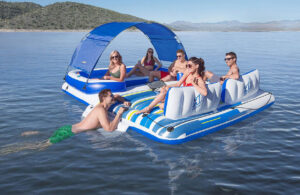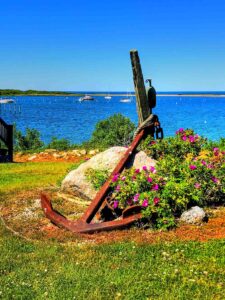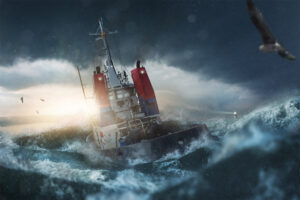
Resting at the bottom of our enigmatic ocean floor, thousands of shipwrecks hold stories deep-rooted in the world’s maritime past. From bloody wars and voyages to conquer the New World, to treasure quests and foreign trade, these battered relics leave behind a history of colonial exploration, expansion and the birth of nations. Our oceans hold around 3 million shipwrecks across the planet — some are fabled tales, and others are mysteries that linger. Despite morbid stories surrounding the ships’ accidents, many now have environmental benefits and were intentionally sunk to create artificial reefs and marine life habitat growth. Florida’s waters are home to thousands of shipwrecks that have become wondrous dive sites for adventures and explorers. Check out the history of these notable shipwreck trails spanning from north to south Florida on both the Gulf and Atlantic coasts.
NORTH
Florida Panhandle Shipwreck Trail
PENSACOLA
Emanuel Point Wreck, 1559
Along the Florida panhandle, the remains of two ships from Tristan de Luna y Arellano’s 16th century Spanish fleet are scattered along Pensacola Bay. During their expedition to colonize Florida in the 1500s, a hurricane sunk the ships near Emanuel Point. On a submerged sandbar, parts are scattered, and now only the bottom of the hull is visible.
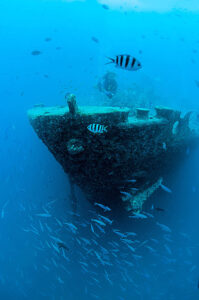
San Pablo, 1942
Nicknamed the “Russian Freighter,” rumors of this vessel’s connection to Soviet espionage circulated when this ship went down, but the truth is even more interesting. It was actually sunk off the coast of Pensacola in 1942 by the U.S. government in a top-secret operation experimenting with explosive-filled speedboats. It now lies 80 feet below the sea where scuba divers can swim along the wreck and explore the exposed boilers.
DESTIN
Miss Louise, 1997
Resting at a depth of 60 feet upon a sandy bottom, this push tug spans 95 feet across the seaboard. It was sunk in 1997 as an artificial reef where exotic fish now thrive, making an excellent dive site. Just off the coast of Destin, divers can witness Spanish mackerel, barracudas, pelagic fish and maybe even a whale shark.
PANAMA CITY
Black Bart, 1993
Built in 1977, this 185-foot oil field supply ship was sunk as an artificial reef in 1993 and renamed in memory of the Navy Supervisor of Salvage in Panama City, Captain Charles “Black Bart” Bartholomew. Divers can explore the top of the intact wheelhouse, the deck, and galley (complete with toilets), and then descend 80 feet to the open cargo at the bottom.
E.E. Simpson, 1929
Sitting in about 20 feet of water just a half-mile off the shore of East Pass, this 1877 tugboat was named for a Pensacola lumberman who owned a sawmill that became the largest industrial firm in Florida. In October 1929, the tugboat was called to help a fishing schooner that ran aground trying to enter St. Andrews Bay. After more than a day attempting the rescue, the vessel eventually sank from rough, unforgiving waves.
PORT ST. JOE
Vamar, 1942
Another easy, shallow dive, this steamer sits in 25 feet of water and is flush with sea life. The 170-foot ship became famous for carrying Admiral Richard E. Byrd’s 1928 American expedition to Antarctica. It then became a tramp freighter and sunk under “mysterious circumstances” leaving Port St. Joe in March 1942. According to legend, it capsized from being overloaded, while others speculate it was a personal sabotage to block the channel, which eventually led to a Coast Guard investigation.
SOUTH
Biscayne National Park’s Maritime Heritage Trail
MIAMI
Erl King, 1891
Built in Scotland in 1865 and named after a mythological mischief-making elf in German literature, this three-masted steamer was a rather unlucky ship. Erl King was involved in trade between China and Australia, and in 1881 it ran aground at Tennessee Reef, was repaired and returned to the sea. Ten years later, she ran aground on Long Reef, which became her final resting place. Now, the barrel-shaped concrete is the only part left sitting in 18 feet of water.
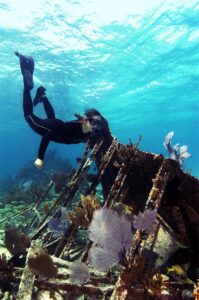
Lugano, 1913
In March 1913, high winds caused this British steamer carrying 116 passengers of mostly Spanish immigrants en route to Cuba to run aground on Long Reef. The passengers were safely rescued while the captain and crew remained onboard. The crew removed the cargo and the hold was intentionally flooded to prevent pounding against the rocks. It was eventually abandoned and now lies in 25 feet of water as a popular dive site.
Mandalay, 1966
This beautiful luxury schooner was made of mahogany, brass and ivory with a teak deck. The spacious vessel had two main rooms for the owner, a large guest room and three single staterooms with their own baths, as well as a living room, washroom and spacious saloon. Passengers returning from a 10-day Bahamian cruise were awakened overnight when the ship crashed due to the captain’s miscalculation. Divers can now witness the skeleton of the 112-foot schooner at the bottom of Biscayne National Park.
Florida Keys Natural Marine Sanctuary Shipwreck Trail
KEY LARGO
Benwood, 1942
Built in 1910 and hailing from England, this 360-foot long merchant marine freighter carried ore and was armed with 12 rifles, six depth charges, a four-inch gun and 36 bombs. Transporting a cargo of phosphate rock from Tampa, FL, to Norfolk, VA, in 1942, the Benwood sunk when it collided with another ship. Lying between French Reef and Dixie Shoals, divers can now explore the low-profile reef from 25 to 45 feet.
ISLAMORADA
San Pedro, 1733
Just off the coast of Lower Matecumbe Key, this shipwreck site is one of Florida’s oldest artificial reefs. Leaving for Spain from Havana, Cuba in 1733, the voyage was led by the Nuestra España Fleet, one of the last Spanish treasure fleets to cross the Atlantic. A brutal hurricane scattered the fleet of three galleons and 18 merchant ships across 30 miles of the Florida Keys on Friday the 13th. It was established as the San Pedro Underwater Archaeological Preserve in 1989 and is now protected under Florida’s Shipwreck Park System.
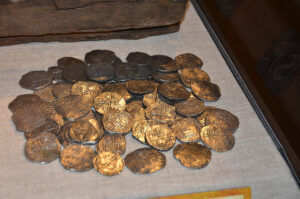
DRY TORTUGAS
Nuestra Señorade Atocha, 1622
This tragic wreck of a return voyage from America to Spain is known as “the world’s most valuable shipwreck.” It was struck by a hurricane in 1622 and sank with a load of precious cargo — 40 tons of gold and silver, 70 pounds of Colombian emeralds and 260 people. About 300 years later, renowned diver Mel Fisher and his treasure salvors crew discovered bits and pieces of the wreck over a 16-year exploration. Preserved artifacts are on display at the Mel Fisher Maritime Museum in Key West.
Santa Margarita, 1622
Soon after Mel Fisher found the Nuestra Señora de Atocha shipwreck on his treasure hunt, sister ship Santa Margarita was also discovered along the Dry Tortugas. Second in riches to Atocha, this 600-ton Spanish galleon was armed with 25 cannons, as well as tons of gold and silver. About $25 million in treasures and artifacts were discovered from this wreck, but millions were never to be seen again.
Other Notable Shipwreck Trails Include the Following:
POMPANO BEACH
Wreck Trek Pompano:
Jay Dorman, 1987
Alpha, 1989
Quallman Tugs, 2000
FORT LAUDERDALE
Fort Lauderdale Wreck Trek:
Jay Scutti, 1986
Tracey, 1999
Merci Jesus, 1998
FLORIDA KEYS
Shipwrecks across the Keys:
Spiegel Grove, 2002
Bibb & Duane, 1987
The Eagle, 1985
Thunderbolt, 1986
Adolphus Busch, 1998
Wilkes-Barre, 1972
Joe’s Tug, 1989



